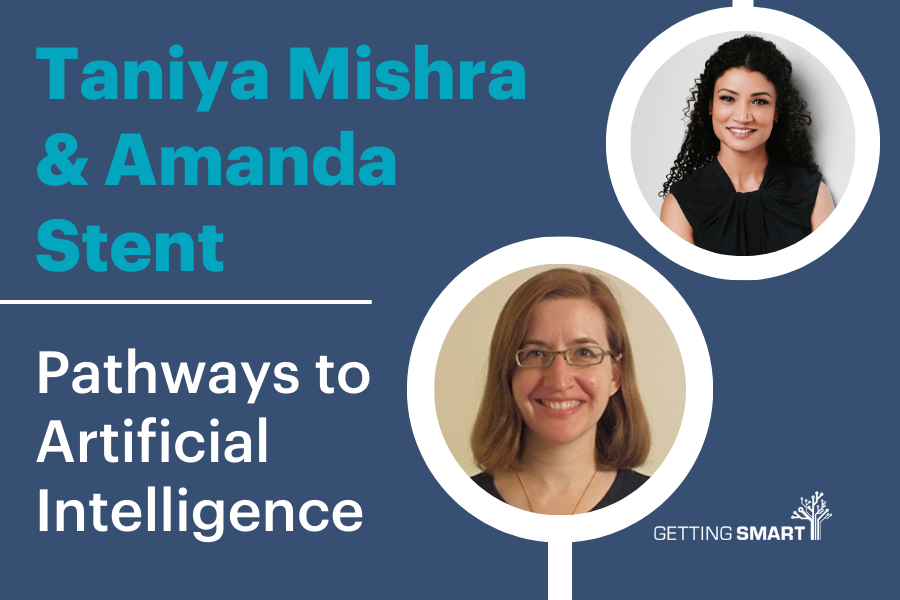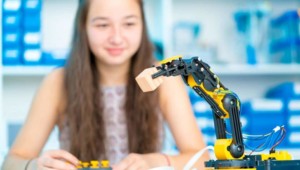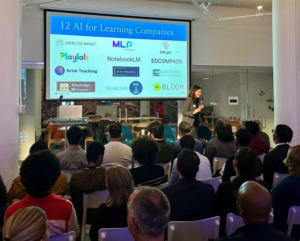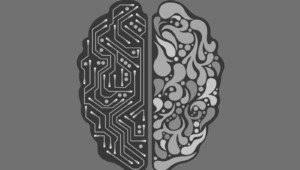Taniya Mishra and Amanda Stent on Pathways to Artificial Intelligence
Key Points
-
We need to create degree pathways that incorporate computational sciences rather than making cross-disciplinary interested folks double majors.
-
Developing an understanding of AI is about so much more than becoming a programmer.

This episode of the Getting Smart Podcast is a part of our New Pathways campaign. In partnership with American Student Assistance (ASA), the Bill & Melinda Gates Foundation, Stand Together and the Walton Family Foundation, the New Pathways campaign will question education’s status quo and propose new methods of giving students a chance to experience success in what’s next.
On this episode of the Getting Smart Podcast Tom Vander Ark is joined by Dr. Amanda Stent, director of the Davis Institute for Artificial Intelligence, and Dr Taniya Mishra, founder and CEO of SureStart. Administered by Colby’s Davis Institute for Artificial Intelligence and the Halloran Lab for Entrepreneurship, the summer-long SureStart curriculum at Colby evolved from a longtime friendship between the two guests.
The Davis Institute for AI facilitates interdisciplinary, human-centered scholarship using rich datasets with real-world consequences and prepares students for a future where AI is transforming industries, careers, and modes of discovery, creativity, and scholarship.
A new generation of ethical AI designers spent eight weeks at Colby this summer for a start-up boot camp called SureStart. In addition to nine rising sophomores from Colby, the program attracted four students from partner school Lincoln University in Pennsylvania, the nation’s first degree-granting historically black college or university. The program aimed to teach students with an interest in AI skills to develop a well-researched and market-ready product that solves a real-world problem with a convenient and cost-effective solution. Students also had the opportunity to work with SureStart mentors including partners from organizations such as Alethea, Lockheed Martin, and Bloomberg Second Measure.
This episode highlights the programs and connections that got this initiative started.
Transcript
Tom: Artificial intelligence has been around for more than 50 years, but it exploded into the consumer sector about a year ago with the rise of generative artificial intelligence. Most schools and colleges are still trying to figure out what happened and what to do about it. One of the national leaders in this area is Colby College. Thanks to a large gift more than two years ago, Colby College created the Davis Institute for Artificial Intelligence, aiming to introduce young people to the extraordinary power and potential of artificial intelligence across the curriculum. Today, we’re joined by Dr. Amanda Stent, the director of Colby’s Davis Institute for Artificial Intelligence. Amanda, welcome.
Amanda: Thank you.
Tom: Amanda has also been working with Dr. Tanya Mishra, founder and CEO of SureStart. She’s based in New York City, but they’ve had a beautiful collaboration, including but not limited to Colby students. We welcome Tanya as well.
Taniya Mishra: Thank you, Tom. Delighted to be here.
Tom: You both have had fascinating journeys in AI and machine learning. AI isn’t new to you, so I’d love for you both to give us a short version of your introductions to and paths in AI and ML. Amanda, how did you get into this field, and can you describe your journey to Colby?
Amanda: Sure. I became interested in AI in high school. I went to high school in a different country under the British educational system, where AI was an optional module for one of our exams. I fell in love with the idea that you could tell a computer true things, and it would tell you more true things. Back then, AI was all about logic, which is different from today. Now, you tell a computer true things, and it may or may not tell you something true back—it’s a completely different story. But since then, I’ve been fascinated by the idea that we can mimic aspects of human intelligence and model it using computers. After high school, I went to college, majored in math and music, and minored in computer science and French, somewhat by accident. Later, I attended graduate school for AI, became a faculty member at Stony Brook University on Long Island, and eventually transitioned to industry.
I worked at AT&T Research, where I met Tanya. We collaborated on some papers with another researcher, and after that, I moved on to Yahoo Labs and then to Bloomberg, where I was a product manager. At Bloomberg, I always had the intention of eventually returning to an undergraduate-focused institution. In 2021, Colby contacted me, saying they were building this institute, focused on undergraduates, and located in Maine—a beautiful place. I resonated with the institute’s mission, so I was excited to come to Colby.
Tom: Amanda, I’m a big fan of Bloomberg GPT, which is a sector-specific finance application of generative AI. When you were at Bloomberg, did you envision creating something like that—a sector-specific AI tool?
Amanda: When I left Bloomberg, we were just starting that project.
Tom: That must have been an amazing experience for you, helping you imagine applications across the curriculum at Colby. Tanya, how did you get interested in AI and ML?
Taniya Mishra: Listening to Amanda talk about her journey made me reflect on my own. I attended a liberal arts school in Minnesota called St. Mary’s University, where I was lucky to receive a National Science Foundation grant as a senior. Although I was an emerging computer scientist, I always saw computer science as such a visual field. Back then, it was very visual; for example, if you opened a brace and didn’t close it, your code would break, and colors would help you see that. I had a classmate with a visual impairment, and I saw how challenging it was for her. So, when given the opportunity to work on a project, I chose to make computing more accessible to those with vision impairments. We worked on creating an audio-based environment for coding, using early forms of voice and audio synthesis, which was groundbreaking in 2001. That experience got me hooked on AI.
After finishing my undergrad, I pursued a Ph.D. in computer science at Oregon Health & Science University. It was an interdisciplinary center known for speech and language research, bringing together computer scientists, linguists, and medical professionals. I happened to watch a PBS show that discussed teaching children born deaf how to speak using AI, and I thought, “This is where I want to go for my Ph.D.” So, I went to OHSU, where my thesis was focused on building voice synthesis systems for children on the autism spectrum, helping them negotiate social interactions by exposing them to storytelling techniques.
That thesis, which would now be categorized as generative AI, taught me a lot about the nuances of communication. I joined AT&T Research afterward, where I met Amanda. Not only was she a co-author on several papers, but she was also one of my first professional mentors. She taught me about technology and how to make space for myself in a field where women and people of color are underrepresented. After AT&T, I moved to Affectiva, a spin-off from MIT’s Media Lab, as head of AI research. In 2020, I started my own company, SureStart, to create accessible pathways into AI for more people, because I’ve seen how closed-off the field can be.
Tom: Tanya, I wonder if you walk around New York with a knowing smile, thinking, “I knew AI was going to be big 20 years ago.”
Taniya Mishra: There are many reasons to smile in New York, but honestly, I didn’t know where we’d end up when I graduated in 2008. Most people told me that there wasn’t a career in synthesis and AI, and that I should just become a general programmer. It’s been an interesting road, watching AI go from something almost obscure to something everyone—from professors to people in my family—asks me about.
Tom: I love that you came into this through accessibility tech and that you, like Dr. Stent, have worked to create pathways for others to explore AI’s power. Dr. Stent, could you tell us about the origins of the Davis Institute and the mission behind it?
Amanda: The Davis Institute for AI was made possible by a generous gift from the Andrew Davis Family Foundation, with trustee Andrew Davis, a Colby alumnus, spearheading the initiative. The gift came in 2021, just before AI made headlines with advances like ChatGPT. The institute’s founding principles are based on the belief that everyone is a participant in an increasingly AI-driven, socio-technical system, with AI applications permeating areas like social media, shopping recommendations, and personal tracking.
Our mission is to enable people to become informed, critical consumers of AI, to make reasonable judgments, and to empower those who wish to become AI tool users or builders within their disciplines. We believe the best AI tools for specific fields, like biology or economics, are created with biologists or economists involved, rather than by technologists imposing solutions from the outside. There’s also a strong focus on ethical AI development and ensuring diversity in the field.
Tom: It’s fantastic that you had a bit of a head start before generative AI took off. I’d love to hear more about how you’re working with Colby faculty to incorporate AI and ML across the curriculum.
Amanda: At Davis AI, we operate like an agile organization. Rather than making five-year plans, we make semester-by-semester plans with long-term goals. One of our five-year goals is to have 25% of Colby faculty and 80% of departments involved in interdisciplinary AI scholarship or teaching. Last academic year, we had over 600 student seats in AI-related courses across the curriculum and collaborated with about 70 faculty members across 70% of departments.
We’re working on diverse projects, from mapping emissions in forests using machine learning to studying cultural and language change over decades with digital humanities. In teaching, we have courses in areas like anthropology, philosophy, and economics incorporating AI concepts. We also developed new courses in computational thinking for first-year students.
Tom: It’s so vital for students in every field to see the computational aspect of their discipline. At Getting Smart, we believe every student should understand the basics of computational thinking.
Amanda: I’d like to recognize my colleagues in computer science who have been creating interdisciplinary approaches to computational thinking for the past eight years. They developed courses that teach programming across fields like visual arts and natural sciences. Tanya and I have discussed how AI is evolving from being a subfield of computer science to something more interdisciplinary, and I think we’ll see the need for both computational and AI-focused thinking in the future.
Tom: I also want to highlight the Holleran Lab for Entrepreneurship. It’s another great sponsor of SureStart. We’re big advocates for incorporating an entrepreneurial mindset alongside AI education, and it’s great to see that in action at Colby.
Amanda: Yes, the new director of the Holleran Lab introduced our students to ethnographic research skills, teaching them how to understand potential stakeholders and consider the broader implications of their ideas. It’s crucial to have conversations with those who might use or be impacted by a product before diving into development. The skills they bring are invaluable for entrepreneurs.
Tom: Tanya, could you tell us more about SureStart and your partnership with Colby?
Taniya Mishra: SureStart is an AI-focused education startup that provides accessible AI skills and innovation training programs. Our programs serve students from middle school through college, covering a range of computational skill levels. We focus on early exposure to big ideas, learning by doing, and amplifying new perspectives in AI. Our partnership with Colby and the Davis Institute aligns perfectly since we share a commitment to entrepreneurship and bringing diverse voices into AI. Working with Amanda at Colby has been a wonderful experience, allowing us to test and expand our virtual curriculum to an in-person program.
Amanda: Most of the students in our first cohort were rising sophomores. Starting them early with these skills gives them more time to build AI and entrepreneurship portfolios while they’re still in college. In fact, one of our summer teams recently won the Maine Entrepreneurship Challenge. Their project, called Scholar Sheets, uses AI to personalize scholarship searches, a relevant tool for many students.
Taniya Mishra: Scholar Sheets is an incredible project, not only because it addresses a real problem but also because it was born from a student’s personal experience. This project exemplifies AI’s potential to empower others, create efficiency, and democratize access.
Tom: SureStart is a fantastic program. I’ll also mention some other great summer on-ramp programs, like TFA’s Reinvention Lab and the Penn State Readiness Institute’s AI boot camp. Are there any other programs you’d recommend?
Amanda: For programmers, I’m a huge fan of Fast.ai, which offers deep learning courses for coders.
Taniya Mishra: I also recommend AI for All. They do a wonderful job of introducing students to big ideas in AI and building foundational skills.
Tom: Great suggestions. We’ll include those in the show notes. Amanda and Tanya, we appreciate everything you’re doing to lead in AI education. Could you share some closing advice for faculty, maybe high school or university, who are just starting with AI?
Amanda: Understanding AI goes beyond programming. Faculty and students can approach AI from anthropology, sociology, ethics, and more. AI is so pervasive that there are countless ways to explore it with students beyond coding.
Tom: I appreciate your focus on ethics, Amanda. We can start discussing the ethics of human-computer interaction as early as middle school. Tanya, any final words of advice?
Taniya Mishra: AI is meant to be a neutral tool, empowering and enabling all of us. But ensuring it remains inclusive requires a focus on responsible AI principles, keeping humans at the center of AI development and deployment.
Tom: Thanks to Dr. Tanya Mishra, CEO of SureStart, and Dr. Amanda Stent, director of the Davis Institute at Colby College. We appreciate your leadership in AI and your work creating on-ramps for learners. Thanks to our producer, Mason Pasha, and the Getting Smart team. Until next week, keep learning, keep leading, and find an AI on-ramp for yourself. See you next week.
Links:








0 Comments
Leave a Comment
Your email address will not be published. All fields are required.